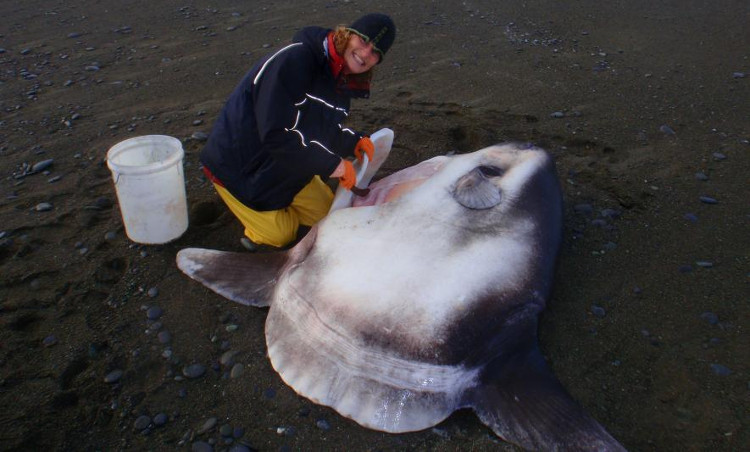Discovered a new giant moonfish, weighing up to 2 tons
A new moonfish has just been identified after a four-year search, National Geographic reported.
Despite being the largest bone fish in the world and weighing more than two tons, moon fish is quite reclusive, making searching for the past four years very difficult.

Marianne Nyegaard took pictures with the moon fish Hoodwinker ashore in New Zealand in 2014.
The team led by Marianne Nyegaard, a graduate student at Murdoch University in Australia, analyzed more than 150 samples of moonfish DNA and discovered four separate species of this genus. However, only three species have been identified before.
This led Nyegaard to believe that another species of moonfish has not been recorded. But she didn't know what it looked like or where.
The team decided to name the fourth fish moonfish Hoodwinker , which means 'hidden'. A year later, Nyegaard had a chance to see the moon fish Hoodwinker.

Hoodwinker has become the first new moonfish discovered in 130 years.
In 2014, she received a phone call from New Zealand fishermen saying that the four moon fish had just landed on the Christchurch coast. Nyegaard came and witnessed the giant creature with his own eyes.
After the incident, researchers from many universities around the world collected and analyzed specimens from fish that washed ashore and proved it to be a new species. So, Moon Moon Hoodwinker has become the first new moonfish discovered in 130 years.

A moonfish Hoodwinker in the Chilean sea.
Hoodwinker has many differences with the other three species. Hoodwinker has a sleeker and sleeker body, without a bump or muzzle like other moon fishes.
Nyegaard and his team later discovered moon fish Hoodwinker in New Zealand, South Australia, or South Africa and southern Chile. This suggests that they can live colder regions in the Southern Hemisphere, Nyegaard wrote in a scientific paper.
The giant shape of moon fish helps them stay warm when diving deep into the ocean. Size also makes it easier to float to the surface for heating.
- The second treasure was discovered under the sea
- Moon fish can weigh more than two tons
- Discover super big tyrant dinosaurs
- Detecting dinosaurs 26m long, weighing 65 tons
- Catch huge pythons weighing 100kg
- Sentences are sharks that weigh a record of 2 tons
- Giant moonfish come to the museum
- Giant fossils and the fear of prehistoric creatures
- Peru strives to protect the rays that weigh up to two tons
- Discovered an ancient stone statue weighing 12.5 tons in Mexico City
- China: Drive a bus through a giant glass bridge to demonstrate the safety of the bridge
- Meteorites like 65,000 atomic bombs are about to stab the Earth?
 Surprised: Fish that live in the dark ocean still see colors
Surprised: Fish that live in the dark ocean still see colors Japan suddenly caught the creature that caused the earthquake in the legend
Japan suddenly caught the creature that caused the earthquake in the legend A series of gray whale carcasses washed ashore on California's coast
A series of gray whale carcasses washed ashore on California's coast Compare the size of shark species in the world
Compare the size of shark species in the world